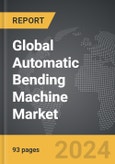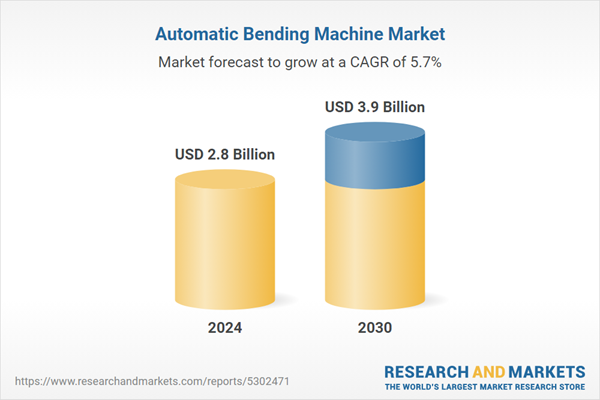Global Automatic Bending Machine Market - Key Trends and Drivers Summarized
What Are Automatic Bending Machines and How Do They Operate?
Automatic Bending Machines are advanced industrial devices designed to automate the process of bending metals and other materials with high precision, consistency, and efficiency. These machines are widely used in metal fabrication, where they play a crucial role in shaping sheets, tubes, and rods into specified angles, curves, or custom forms for applications in sectors like automotive, aerospace, construction, and manufacturing. Unlike traditional bending methods that require skilled operators and manual adjustments, automatic bending machines use programmed control systems to execute complex bends automatically. Equipped with CNC (Computer Numerical Control) technology, these machines receive digital instructions, translating specifications into precise movements that control bending tools with exacting accuracy. This precision is critical in high-stakes applications where even minor deviations in angle or shape could lead to material wastage, quality issues, or assembly complications. By automating the bending process, these machines minimize human error, reduce setup time, and increase output, making them essential for facilities aiming to improve productivity and meet the high demands of modern manufacturing.What Technological Innovations Are Behind the Efficiency and Accuracy of Automatic Bending Machines?
The efficiency and accuracy of Automatic Bending Machines are powered by a blend of CNC technology, robotics, and machine learning, each bringing unique enhancements that have reshaped the capabilities of these machines. CNC control is the backbone of automatic bending, providing the ability to program and execute complex bends with remarkable precision, adjusting for material thickness, elasticity, and bend angles without manual recalibration. Robotic arms and grippers further automate the handling and positioning of materials, allowing seamless transitions between bends and reducing cycle times. This robotic integration is particularly beneficial in high-volume production environments where speed and repeatability are crucial. Machine learning algorithms contribute to the accuracy and adaptability of these machines by analyzing bending data and refining processes over time, enabling them to optimize settings for different materials and reduce trial-and-error adjustments. Many automatic bending machines are also equipped with sensors and vision systems that monitor real-time bending progress, allowing for immediate corrections if discrepancies are detected. These innovations collectively make automatic bending machines more versatile and capable of handling a wide range of materials, thicknesses, and designs with unparalleled accuracy and consistency, transforming them into highly valuable assets in any advanced manufacturing setting.Where Are Automatic Bending Machines Making the Biggest Impact?
Automatic Bending Machines have become indispensable in industries that demand precise, high-volume metalworking, particularly in sectors like automotive, aerospace, construction, and appliance manufacturing. In the automotive industry, where components require exacting specifications to ensure safe and efficient assembly, automatic bending machines are essential for producing parts like frames, exhaust pipes, and brackets with uniform bends that fit seamlessly into vehicle structures. In aerospace, the stringent quality standards and high-stakes nature of production require bending machines that can achieve near-perfect precision in forming complex components for aircraft fuselages, wings, and other structural parts. The construction industry also benefits from these machines in the fabrication of metal reinforcements, structural beams, and custom architectural elements, where speed and durability are paramount. Additionally, appliance manufacturing, which relies on repeatable bends for enclosures, structural frames, and other metal components, has seen improved efficiency with automatic bending machines that can quickly switch between different shapes and sizes without extensive reprogramming. By automating complex bending tasks, these machines not only enhance productivity and accuracy across these sectors but also contribute to reducing material wastage, improving cost efficiency, and maintaining high standards of quality and consistency essential in these critical industries.What's Fueling the Expansion of the Automatic Bending Machine Market?
The growth in the Automatic Bending Machine market is driven by several key factors, including technological advancements, increasing demand for precision fabrication, and a need for cost-effective, high-volume production in various manufacturing sectors. One of the main drivers is the rise of CNC and robotic technologies, which have made these machines more accurate, programmable, and capable of performing complex bends with minimal human intervention. The ongoing trend towards Industry 4.0 and smart manufacturing is also fueling the adoption of automatic bending machines, as manufacturers seek solutions that can integrate seamlessly with automated workflows and provide real-time data for monitoring and optimizing production processes. The growing demand for precision and uniformity in metal parts, especially in high-stakes industries like automotive and aerospace, has further accelerated market growth, as these sectors require bending solutions that can meet stringent quality standards consistently. Another significant factor is the pressure to reduce production costs and improve efficiency; automatic bending machines address this by minimizing waste, reducing labor requirements, and cutting down cycle times, making them economically appealing for manufacturers. Additionally, the need for flexible production capabilities is pushing adoption, as these machines can easily be reprogrammed for different parts or projects, enabling manufacturers to adapt quickly to changes in demand or product designs. Finally, as sustainability becomes a priority in manufacturing, automatic bending machines support these goals by optimizing material use and reducing energy consumption, aligning with the broader push towards greener, more efficient production methods. These factors collectively underscore the rapid growth and adoption of automatic bending machines, establishing them as integral tools in the pursuit of advanced, efficient, and sustainable manufacturing.Report Scope
The report analyzes the Automatic Bending Machine market, presented in terms of market value (US$ Thousand). The analysis covers the key segments and geographic regions outlined below.- Segments: Type (Automatic, Semi-Automatic); Technology (Electric, Hydraulic, Pneumatic, Induction); Application (Tube / Pipe, Metal Sheet, Bar); End-Use (Automotive, Aerospace, Shipbuilding, Other End-Uses).
- Geographic Regions/Countries:World; United States; Canada; Japan; China; Europe (France; Germany; Italy; United Kingdom; and Rest of Europe); Asia-Pacific; Rest of World.
Key Insights:
- Market Growth: Understand the significant growth trajectory of the Automatic Machine segment, which is expected to reach US$2.6 Billion by 2030 with a CAGR of a 6%. The Semi-Automatic Machine segment is also set to grow at 5.3% CAGR over the analysis period.
- Regional Analysis: Gain insights into the U.S. market, valued at $756.5 Million in 2024, and China, forecasted to grow at an impressive 5.6% CAGR to reach $616.1 Million by 2030. Discover growth trends in other key regions, including Japan, Canada, Germany, and the Asia-Pacific.
Why You Should Buy This Report:
- Detailed Market Analysis: Access a thorough analysis of the Global Automatic Bending Machine Market, covering all major geographic regions and market segments.
- Competitive Insights: Get an overview of the competitive landscape, including the market presence of major players across different geographies.
- Future Trends and Drivers: Understand the key trends and drivers shaping the future of the Global Automatic Bending Machine Market.
- Actionable Insights: Benefit from actionable insights that can help you identify new revenue opportunities and make strategic business decisions.
Key Questions Answered:
- How is the Global Automatic Bending Machine Market expected to evolve by 2030?
- What are the main drivers and restraints affecting the market?
- Which market segments will grow the most over the forecast period?
- How will market shares for different regions and segments change by 2030?
- Who are the leading players in the market, and what are their prospects?
Report Features:
- Comprehensive Market Data: Independent analysis of annual sales and market forecasts in US$ Million from 2024 to 2030.
- In-Depth Regional Analysis: Detailed insights into key markets, including the U.S., China, Japan, Canada, Europe, Asia-Pacific, Latin America, Middle East, and Africa.
- Company Profiles: Coverage of players such as Amada, Amob, BLM, Bystronic, Danobatgroup and more.
- Complimentary Updates: Receive free report updates for one year to keep you informed of the latest market developments.
Some of the 42 companies featured in this Automatic Bending Machine market report include:
- Amada
- Amob
- BLM
- Bystronic
- Danobatgroup
- Dural Machinery
- Euromac
- Haco
- Horn Machine Tools
- Kersten
This edition integrates the latest global trade and economic shifts into comprehensive market analysis. Key updates include:
- Tariff and Trade Impact: Insights into global tariff negotiations across 180+ countries, with analysis of supply chain turbulence, sourcing disruptions, and geographic realignment. Special focus on 2025 as a pivotal year for trade tensions, including updated perspectives on the Trump-era tariffs.
- Adjusted Forecasts and Analytics: Revised global and regional market forecasts through 2030, incorporating tariff effects, economic uncertainty, and structural changes in globalization. Includes historical analysis from 2015 to 2023.
- Strategic Market Dynamics: Evaluation of revised market prospects, regional outlooks, and key economic indicators such as population and urbanization trends.
- Innovation & Technology Trends: Latest developments in product and process innovation, emerging technologies, and key industry drivers shaping the competitive landscape.
- Competitive Intelligence: Updated global market share estimates for 2025, competitive positioning of major players (Strong/Active/Niche/Trivial), and refined focus on leading global brands and core players.
- Expert Insight & Commentary: Strategic analysis from economists, trade experts, and domain specialists to contextualize market shifts and identify emerging opportunities.
Table of Contents
Companies Mentioned (Partial List)
A selection of companies mentioned in this report includes, but is not limited to:
- Amada
- Amob
- BLM
- Bystronic
- Danobatgroup
- Dural Machinery
- Euromac
- Haco
- Horn Machine Tools
- Kersten
Table Information
| Report Attribute | Details |
|---|---|
| No. of Pages | 276 |
| Published | December 2025 |
| Forecast Period | 2024 - 2030 |
| Estimated Market Value ( USD | $ 2.8 Billion |
| Forecasted Market Value ( USD | $ 3.9 Billion |
| Compound Annual Growth Rate | 5.7% |
| Regions Covered | Global |









